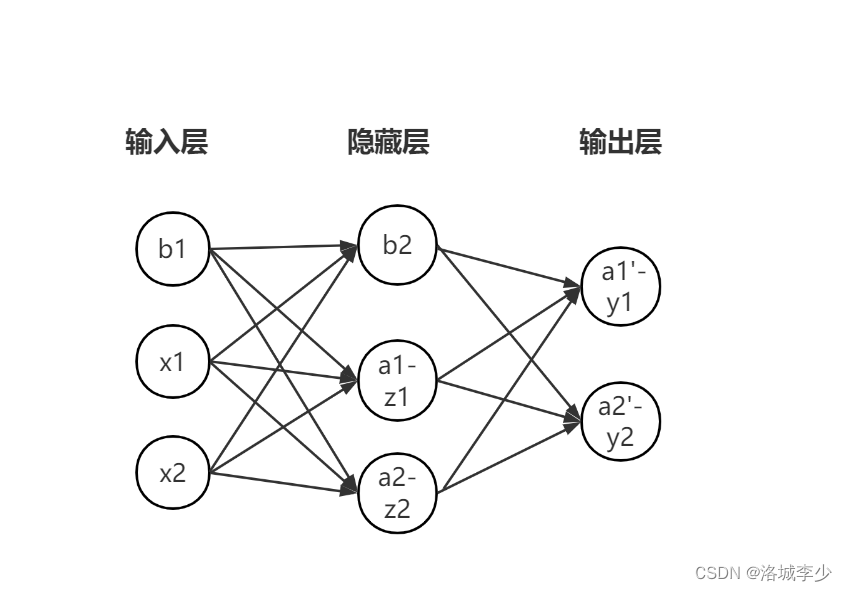图形解释

画图软件不太常用
代码实现
import numpy as np
def numerical_gradient(f,x):
h=1e-4
# 生成与x形状相同的数组
grad=np.zeros_like(x)
for idx in range(x.size):
tmp_val=x[idx]
x[idx]=tmp_val+h
fxh1=f(x)
x[idx]=tmp_val-h
fxh2=f(x)
grad[idx]=(fxh1-fxh2)/2*h
x[idx]=tmp_val
return grad
def sigmold(x):
return 1/(1+np.exp(-x))
def softmax(a):
c=np.max(a)
exp_a=np.exp(a-c)
sum_exp_a=np.sum(exp_a)
y=exp_a/sum_exp_a
return y
def cross_enroty_errorly(y,t):
if y.ndim==1:
t=t.reshape(1,t.size)
y=y.reshape(1,y.size)
batch_size=y.shape(0)
return -np.sum(np.log(y[np.arange(batch_size),t]+1e-7))/batch_size
class TwolayerNet:
def __init__(self,input_size,hidden_size,output_size,weight_init_std=0.01):
self.params={}
self.params["w1"]=weight_init_std*np.random.randn(input_size,hidden_size)
self.params["w2"]=weight_init_std*np.random.randn(hidden_size,output_size)
self.params["b1"]=np.zeros(hidden_size)
self.params["b2"]=np.zeros(output_size)
def predict(self,x):
w1,w2=self.params["w1"],self.params["w2"]
b1,b2=self.params["b1"],self.params["b2"]
a1 = np.dot(x,w1) + b1
z1 = sigmold(a1)
a2 = np.dot(z1,w2) + b1
y=softmax(a2)
return y
def loss(self,x,t):
y=self.predict(x)
return cross_enroty_errorly(y,t)
def accury(self,x,t):
y=self.predict(x)
y=np.argmax(y,axis=1)
t=np.argmax(1,axis=1)
accury=np.sum(y==t)/float(x.shape[0])
return accury
def numerical_gradient(self,x,t):
loss_w=lambda w:self.loss(x,t)
grads={}
grads["w1"]=(loss_w,self.params["w1"])
grads["b1"] = numerical_gradient(loss_w, self.params["b1"])
grads["w2"] = numerical_gradient(loss_w, self.params["w2"])
grads["b2"] = numerical_gradient(loss_w, self.params["b2"])
return grads
内容解释
高数
两个常用函数
1.sigmoid
该函数实际上就是一个转换器,输入某个数会有值传出。
如h(2.0)=0.731
多用于二元分类问题
def sigmold(x):
return 1/(1+np.exp(-x))
2.softmax
该函数负责完成信号的转换,输出的时概率,且输出的总和为1.
假设输出层有三个神经元,第一个神经元的输出y=该神经元的信号/三个输入信号之和
def softmax(a):
c=np.max(a)
exp_a=np.exp(a-c)
sum_exp_a=np.sum(exp_a)
y=exp_a/sum_exp_a
return y
mini-batch版交叉熵误差
y是神经网络的输出,t是监督数据
计算正确解标签的输出的自然对数
def cross_enroty_errorly(y,t):
if y.ndim==1:
t=t.reshape(1,t.size)
y=y.reshape(1,y.size)
batch_size=y.shape(0)
return -np.sum(np.log(y[np.arange(batch_size),t]+1e-7))/batch_size
梯度
通过数值微分来确定梯度
def numerical_gradient(f,x):
h=1e-4
# 生成与x形状相同的数组
grad=np.zeros_like(x)
for idx in range(x.size):
tmp_val=x[idx]
x[idx]=tmp_val+h
fxh1=f(x)
x[idx]=tmp_val-h
fxh2=f(x)
grad[idx]=(fxh1-fxh2)/2*h
x[idx]=tmp_val
return grad
后记
刚入门,错误的请指出。
